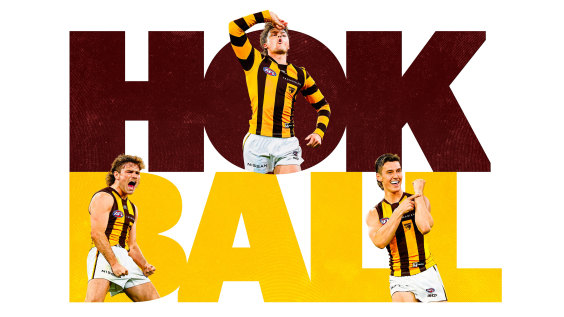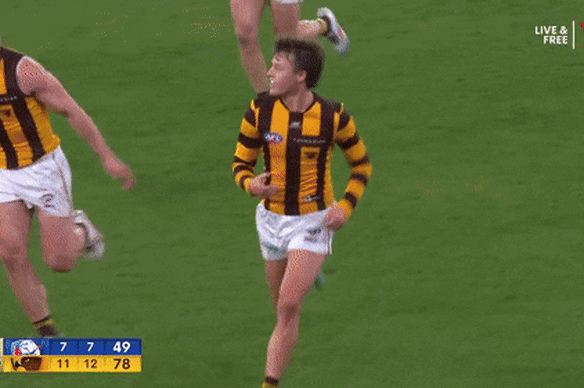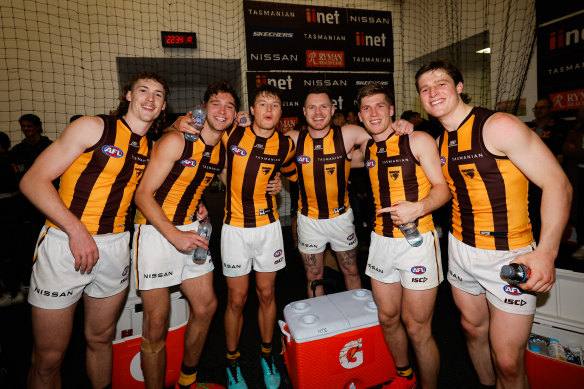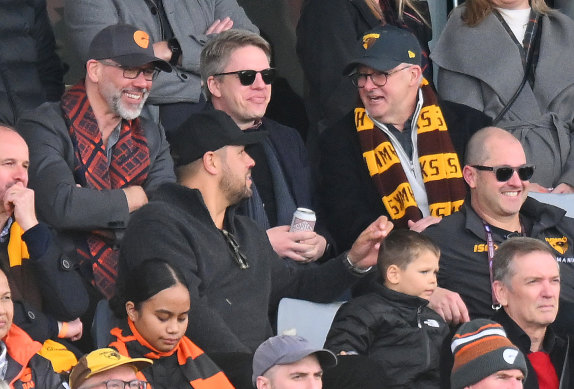By Marnie Vinall, Peter Ryan, Greg Baum and Marc McGowan
Hawthorn have captivated Melbourne, or at least the parts of Melbourne that don’t hate them, surging into an AFL semi-final with a brigade of 20-something young men with mullets and fades. They play fast, exciting footy, but that’s only part of the story. Behind them is a social media phenomenon largely driven by fans, but embraced by the Hawks players whose coach, the previously unsociable Sam Mitchell, has given them a licence for fun. That phenomenon is “Hokball”, and we’ve had a go at decoding it.

Hokball is the latest footy craze.Credit: Stephen Kiprillis
What is ‘Hokball’?
“Hok” is Gen Z slang for “Hawk”. It is, on social media at least, what “Crom” is to Adelaide (“Go Crom!”) and “Norf” is to North Melbourne. While we’re at it, a Sydney fan was in touch on the text after the Swans mowed down Greater Western Sydney on Saturday to snatch victory in their qualifying final: “Go Swom”.
The term “Hokball” appeared on Instagram and in TikTok hashtags last year, but has caught fire in 2024 as the Hawks launched their run to September. But it’s not easy to explain.
As one fan wrote on X: “Skibidi sigma. It means nothing. It means everything.”
Unlike “Bazball” in cricket, an aggressive and fearless style of play built on scoring quick runs to win Test matches, or “Angeball”, the attacking brand of soccer under Tottenham’s Australian coach Ange Postecoglou, Hokball is less a game style than a vibe.
Where did it come from? Even skipper James Sicily doesn’t know. When asked in mid-August to confirm people were calling the way the Hawks play “Hawkball”, he replied: “I think for the older guys it’s called ‘Hawkball’, for the younger generation it’s called ‘Hokball’,” he told 3AW, really emphasising the “Hok”.
“It’s all fun and games. I don’t know where it comes from, but it’s good value.”
And if you ask TikTok, it’s “Pedal metal skibidi Josh Weddle”.
This is how Hawthorn’s social media team explains Hokball. Warning: it doesn’t make a heap of sense.
It might be hard to define Hokball but here’s what it’s not. There’s no suggestion it’s an Australian take on “Hawk Tuah”, the woman whose sex tip video went viral.
Who are the key players in Hokball?

Hawks Nick Watson (left) and Jack Ginnivan promote Hok merchandise.Credit: Instagram
Collingwood of the 2010s had the “rat pack”. Present-day Hawthorn has the “rascal pack”. They are entertainers, led by Jack Ginnivan and Nick “the Wizard” Watson, who have been selling “Hok” merchandise via Instagram.
Coach Sam Mitchell coined the term rascal pack to explain why he wasn’t worried about an on-field clash between teammates Ginnivan and Will Day during a match against Adelaide. Mitchell said the group of players in their early 20s, which also includes Dylan Moore, Weddle and Connor Macdonald, were close friends.
While Mitchell probably isn’t writing “Hokball” on the whiteboard at training, he does encourage his players to be themselves and embrace the antics, when appropriate.
So, Hokball is ... the exuberance of Mabior Chol leapfrogging Watson after a goal, Ginnivan cracking an imaginary beer on the MCG during an elimination final, and gesturing for the Collingwood crowd to “go to sleep” after the Hawks’ win over his old side. And, as the merch claims, it’s rising from 17th on the ladder after losing the first five games of the year to making finals. And it’s all set to a Skrillex, Fred Again and Flowdan hype song.

Jack Ginnivan pulls out a cheeky goal celebration.Credit: Channel Seven
Hang on, can someone please explain all this for the over-25s?
Whatever you want to call whatever it is Hawthorn are doing, it’s engaging. Friday night’s crowd was a record for an elimination final, and the majority were there for Hawthorn. The rooms afterwards were heaving. To a certain extent, all clubs embrace their fans now in a way that once would have been antithetical to the cocoon philosophy of winning premierships, but this was off the scale.

Josh Weddle, Jack Scrimshaw, Jack Ginnivan, Blake Hardwick, Dylan Moore and Josh Ward celebrate in the rooms. Credit: AFL Photos via Getty Images
All that brown and gold gave the room a certain ineffable tint. Don Scott once said it was a colour combination only a Hawthorn fan could love, but this night even Prime Minister Anthony Albanese was sporting a club scarf.
Albanese was in a corner with Hawks president Andy Gowers, beholding the outpouring of joy. “We don’t have a lot of kids among the playing group, but there are cousins and nephews and nieces and so on,” said Gowers. “So yeah, allowing the families to come in and enjoy the win is deliberate – and fantastic.”

Prime Minister Anthony Albanese chats to Lance Franklin at a Hawks match earlier this year.Credit: Getty Images
At a guess, the throng in the rooms skewed to early middle age. Half probably did not know what Hokball was – half, plus one reporter – but they all knew what Hawthorn’s 2024 brand of football was, and were wallowing in it. Yes, it was only one win in a final, but ask Essendon – at one time the Hawks’ fiercest rivals – how much one win in a final counts for.
In the spirit of Hokball, even the Hawks’ leaders were talking up their chances as they would not have in previous, more conservative eras. Last week, Sicily was happy to talk premierships. On Friday night, Gowers recalled that the Hawks had Port Adelaide beaten in Adelaide in May until the Power kicked two goals in the last 22 seconds to snatch it. “We’re a chance, and we go over there with a bit of confidence,” he said of their next assignment.
Who is ‘the Wizard’? And what type of magic does he bring?
Hawthorn’s cheeky first-year goalsneak, Watson, the No.5 pick in last year’s draft, has captured fans’ hearts so much that an army of them turned up with black wizard hats to watch them beat the Western Bulldogs. Watson booted a game-high four goals – all from set shots, which he struggled with until the past two months – in the biggest match of his life, but scouts who watched him long before his AFL days were not surprised.

Nick Watson (aka “the Wizard”) commandeers a wizard hat from the crowd. Credit: AFL Photos
Watson is a gifted kid who some recruiters expect to kick 500-plus goals, which would place him in the company of small forwards Eddie Betts, Stephen Milne and Luke Breust. He was the leading goalkicker in last year’s under-18 championships and admirably dealt with sledges over the fence while representing Caulfield Grammar. Those experiences helped him deal with the challenges of his debut season.
As for “the Wizard” nickname, Watson’s former Eastern Ranges teammates rarely used it other than to tease him.
Inside the club, the teenage star was actually “Bulldog” or “Bull”, but the Hawks won’t care what he’s called if he keeps playing like this.
So we know Hokball is a vibe. But what are they doing differently on the field?
Hawthorn move the ball like lightning, dismantling team defences and confusing opponents. Their team consists of quick runners, good ball users and excellent decision makers, with their recruiters assembling a group who complement each other, believe in each other and like each other.
After Jack Scrimshaw and Sicily take an intercept mark, they either kick immediately to a running teammate, who turns and goes knowing there will be movement ahead, or give off a handball to Karl Amon, Weddle or Jarman Impey, who run with a plan. There is no pondering.
Wingmen and high half-forwards split to space wide, and key forwards and crumbers sprint back to goal, turning their opponents around so they have their back to the play.
All that is possible because of the excellent contest work led by Jai Newcombe, James Worpel, Conor Nash and, when he’s available, Day. They use clean hands and rapid handball to move the ball from the inside to the outside of stoppages. It’s not new to keep the ball in constant motion, but it takes skill most teams don’t possess. And it’s hard to defend.
OK, but will it work at Adelaide Oval, away from the ’G?
Yes, particularly against Port Adelaide, who are vulnerable to quick ball movement. Port’s only chance is to win the clearances and lock the ball inside 50 with ferocious pressure, as they did late in the round 10 classic, when Dan Houston (now suspended) kicked three goals.
Otherwise, there is a chance they will be torn apart as they were by Geelong in the qualifying final. Hawthorn will counter Port’s stoppage game by putting extra half-forwards to the stoppage, congesting play and making it hard for the Power to run out the front. If the Hawks win the clearances, those high half-forwards will be able to outrun their opponents – with Port preferring one-on-one defence – back towards goal.
If the Hawks intercept mark, they will rebound at pace, and because Port’s midfield does not like to defend, Hawthorn will outnumber their opponents forward of the ball.
Like the rascal pack, the Hawks’ game style is high-energy and high intensity. If it lands them in a preliminary final, expect Hokball to break the internet.
Keep up to date with the best AFL coverage in the country. Sign up for the Real Footy newsletter.